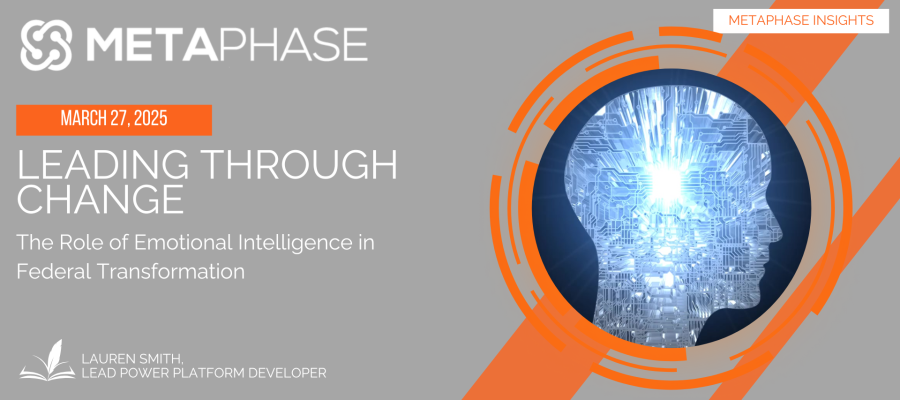
In a world where change is the only constant, why do so many transformation efforts still fail?
Federal agencies are under relentless pressure to adapt. From shifting policy mandates and emerging technologies to evolving workforce expectations, transformation is no longer optional—it’s a necessity. Yet, despite countless change management frameworks and digital modernization initiatives, many agencies struggle to achieve lasting success. Why? Because transformation isn’t just about technology or processes—it’s about people.
Emotional intelligence (EI) is often overlooked in large-scale government change efforts, but it plays a crucial role in whether transitions succeed or fail. Leaders who harness EI can navigate uncertainty, foster resilience, and drive engagement, ensuring that transformation isn’t just mandated but embraced. Combined with technology-driven insights, emotionally intelligent leadership can turn resistance into momentum and complexity into clarity.
The Human Side of Transformation
Change initiatives tend to focus on strategy, tools, and workflows. But at their core, they disrupt routines, challenge assumptions, and introduce uncertainty—conditions that can trigger resistance, anxiety, or disengagement among employees. While policies and technologies evolve, the emotional response to change remains universal: people need purpose, clarity, and trust.
Emotional intelligence provides a framework for leaders to meet these needs. It involves self-awareness, empathy, adaptability, and the ability to manage emotions—both their own and those of their teams. Leaders with high EI can anticipate concerns, communicate effectively, and create an environment where employees feel heard and supported rather than overwhelmed.
Technology as an Enabler, Not a Replacement
The rise of AI, automation, and digital tools has made change management more data-driven, but technology alone cannot drive successful transformation. AI-powered analytics can predict workforce trends, sentiment analysis tools can gauge employee morale, and collaboration platforms can streamline communication—but all of these are only effective when paired with human-centered leadership.
For instance, during major system upgrades, agencies often deploy AI-powered chatbots to answer employee questions. But if those responses lack nuance or fail to acknowledge concerns, frustration builds. Similarly, data-driven decision-making is only as effective as the leaders interpreting the insights and translating them into action with empathy and transparency. Similarly, if automation tools are employed but the process is never streamlined or the data is never cleaned up, the automation will only amplify the inefficiencies present.
Emotional Intelligence in Action
Federal agencies that prioritize emotional intelligence alongside operational strategies see measurable improvements in adoption rates and mission success. Consider the Department of Veterans Affairs, which introduced human-centered design principles alongside its digital transformation efforts, ensuring that technological changes aligned with real employee and veteran needs. By emphasizing user experience and listening to stakeholder feedback, the VA improved adoption rates for new tools and reduced resistance to change.
Another example is the General Services Administration (GSA), which used structured empathy interviews to understand employee concerns before rolling out cloud adoption initiatives. By integrating these insights into their change management strategy, GSA leaders addressed anxieties proactively, leading to smoother transitions and stronger buy-in.
Building an Emotionally Intelligent Agency
So how can federal leaders embed emotional intelligence into their transformation efforts?
- Develop Self-Awareness – Leaders should assess their own emotional responses to change and how they influence decision-making. Training programs and 360-degree feedback can help build this awareness.
- Co-create from the Beginning – Employees that feel included from the very start are more likely to champion a change to their sphere of influence within the organization. Working with the people most likely to be directly affected by the change also helps to create a more holistic solution that effectively solves the right problem instead of implementing new technology for the sake of it.
- Prioritize Transparent Communication – Employees need to understand why change is happening, how it impacts them, and where they can find support. Open forums, town halls, and real-time feedback loops foster trust.
- Empower Middle Management – Change doesn’t just come from the top. Equipping mid-level managers with EI skills ensures they can support their teams effectively through transition periods.
- Leverage Technology for Insights, Not Just Implementation – Sentiment analysis, pulse surveys, and AI-driven engagement tools can provide real-time insights into workforce morale, allowing leaders to address concerns proactively.
- Manage Change Fatigue – Too much change too quickly can lead to lower morale and discontinued support of new initiatives. Being strategic about how much is changed at a given time can give employees time to adapt while still moving the mission forward.
- Recognize and Address Resistance with Empathy – Resistance is a natural part of change. Instead of dismissing it, emotionally intelligent leaders view resistance as an opportunity to listen, understand concerns, and tailor solutions accordingly.
The Future of Government Transformation
The federal workforce is at an inflection point. Agencies that embrace change with emotional intelligence will build cultures of adaptability, innovation, and trust—leading to transformation efforts that don’t just check a box but genuinely succeed. By balancing human connection with technology-driven insights, leaders can guide their teams through uncertainty with confidence and purpose.
MetaPhase works at the intersection of business-to-IT partnerships—creating, deploying, and supporting practical solutions that serve as a force multiplier for government.

